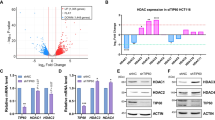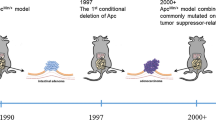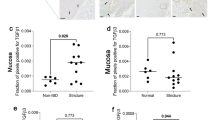Abstract
Colorectal cancer (CRC) is a prevalent cause of cancer and mortality on a global scale. SNAI1, a member of the zinc finger transcription superfamily, is a significant contributor to embryonic development and carcinogenesis through the process of epithelial–mesenchymal transition (EMT). While prior research utilizing CRC cells and clinical data has demonstrated that SNAI1 facilitates CRC progression through diverse mechanisms, the precise manner in which epithelial SNAI1 regulates CRC development in vivo remains unclear. In this study, colitis and colitis-associated CRC were induced through the use of intestinal epithelium-specific Snai1 knockout (Snai1 cKO) mice. Our findings indicate that Snai1 cKO mice exhibit a reduced susceptibility to acute colitis and colitis-associated CRC compared to control mice. Western-blot analysis of colon tissues revealed that Snai1 cKO mice exhibited a higher overall apoptosis level during tumor formation than control mice. No significant differences were observed in the activation of the classical p53 signaling pathway. However, Snai1 cKO mice exhibited weakened EMT and Wnt/β-catenin pathway activation. In summary, our study has provided evidence in vivo that the intestinal epithelial SNAI1 protein suppresses apoptosis, amplifies the EMT, and activates the Wnt/β-catenin signaling pathways in both early and late phases of CRC formation, thus promoting the development and progression of colitis-associated CRC.







Similar content being viewed by others
Data availability
Data will be made available upon reasonable request.
References
Sung H, Ferlay J, Siegel RL, et al. Global cancer statistics 2020: GLOBOCAN estimates of incidence and mortality worldwide for 36 cancers in 185 countries. CA Cancer J Clin. 2021;71(3):209–49.
Arnold M, Abnet CC, Neale RE, et al. Global burden of 5 major types of gastrointestinal cancer. Gastroenterology. 2020;159(1):335-49.e15.
Feletto E, Yu XQ, Lew JB, et al. Trends in colon and rectal cancer incidence in Australia from 1982 to 2014: analysis of data on over 375,000 cases. Cancer Epidemiol Biomark Prev. 2019;28(1):83–90.
Brenner DR, Heer E, Sutherland RL, et al. National trends in colorectal cancer incidence among older and younger adults in Canada. JAMA Netw Open. 2019;2(7): e198090.
Dekker E, Tanis PJ, Vleugels JLA, et al. Colorectal cancer. Lancet (Lond, Engl). 2019;394(10207):1467–80.
Rawla P, Barsouk A, Hadjinicolaou AV, et al. Immunotherapies and targeted therapies in the treatment of metastatic colorectal cancer. Med Sci (Basel, Switzerland). 2019;7(8):83.
Paznekas WA, Okajima K, Schertzer M, et al. Genomic organization, expression, and chromosome location of the human SNAIL gene (SNAI1) and a related processed pseudogene (SNAI1P). Genomics. 1999;62(1):42–9.
Nieto MA. The snail superfamily of zinc-finger transcription factors. Nat Rev Mol Cell Biol. 2002;3(3):155–66.
Swain SD, Grifka-Walk HN, Gripentrog J, et al. Slug and Snail have differential effects in directing colonic epithelial wound healing and partially mediate the restitutive effects of butyrate. Am J Physiol Gastrointest Liver Physiol. 2019;317(4):G531–44.
Du F, Yang R, Ma HL, et al. Expression of transcriptional repressor Slug gene in mouse endometrium and its effect during embryo implantation. Appl Biochem Biotechnol. 2009;157(2):346–55.
Horvay K, Jardé T, Casagranda F, et al. Snai1 regulates cell lineage allocation and stem cell maintenance in the mouse intestinal epithelium. EMBO J. 2015;34(10):1319–35.
Horvay K, Casagranda F, Gany A, et al. Wnt signaling regulates Snai1 expression and cellular localization in the mouse intestinal epithelial stem cell niche. Stem Cells Dev. 2011;20(4):737–45.
Zhang Y, Tu L, Zhou X, et al. MicroRNA-22 regulates the proliferation, drug sensitivity and metastasis of human glioma cells by targeting SNAIL1. J Buon. 2020;25(1):491–6.
Luo WR, Chen XY, Li SY, et al. Neoplastic spindle cells in nasopharyngeal carcinoma show features of epithelial-mesenchymal transition. Histopathology. 2012;61(1):113–22.
de Morais EF, Morais HGF, de França GM, et al. SNAIL1 is involved in the control of the epithelial-mesenchymal transition in oral tongue squamous cell carcinoma. Oral Surg Oral Med Oral Pathol Oral Radiol. 2023;135(4):530–8.
Kaufhold S, Bonavida B. Central role of Snail1 in the regulation of EMT and resistance in cancer: a target for therapeutic intervention. J Exp Clin Cancer Res. 2014;33(1):62.
Wang Y, Shi J, Chai K, et al. The role of Snail in EMT and tumorigenesis. Curr Cancer Drug Targets. 2013;13(9):963–72.
Tanaka S, Kobayashi W, Haraguchi M, et al. Snail1 expression in human colon cancer DLD-1 cells confers invasive properties without N-cadherin expression. Biochem Biophys Rep. 2016;8:120–6.
Ni T, Li XY, Lu N, et al. Snail1-dependent p53 repression regulates expansion and activity of tumour-initiating cells in breast cancer. Nat Cell Biol. 2016;18(11):1221–32.
Freihen V, Rönsch K, Mastroianni J, et al. SNAIL1 employs β-Catenin-LEF1 complexes to control colorectal cancer cell invasion and proliferation. Int J Cancer. 2020;146(8):2229–42.
Kroepil F, Fluegen G, Totikov Z, et al. Down-regulation of CDH1 is associated with expression of SNAI1 in colorectal adenomas. PLoS ONE. 2012;7(9): e46665.
Kroepil F, Fluegen G, Vallböhmer D, et al. Snail1 expression in colorectal cancer and its correlation with clinical and pathological parameters. BMC Cancer. 2013;13:145.
Rashed HE, Hussein S, Mosaad H, et al. Prognostic significance of the genetic and the immunohistochemical expression of epithelial-mesenchymal-related markers in colon cancer. Cancer Biomark. 2017;20(1):107–22.
Scheel C, Onder T, Karnoub A, et al. Adaptation versus selection: the origins of metastatic behavior. Cancer Res. 2007;67(24):11476–9.
Fang J, Ding Z. SNAI1 is a prognostic biomarker and correlated with immune infiltrates in gastrointestinal cancers. Aging. 2020;12(17):17167–208.
Mohammadpour S, Esfahani AT, Karimpour R, et al. High expression of Snail1 is associated with EMAST and poor prognosis in CRC patients. Gastroenterol Hepatol Bed Bench. 2019;12(Suppl1):S30.
Man SM, Zhu Q, Zhu L, et al. Critical role for the DNA sensor AIM2 in stem cell proliferation and cancer. Cell. 2015;162(1):45–58.
Carver EA, Jiang R, Lan Y, et al. The mouse snail gene encodes a key regulator of the epithelial-mesenchymal transition. Mol Cell Biol. 2001;21(23):8184–8.
Ananthakrishnan AN. Epidemiology and risk factors for IBD. Nat Rev Gastroenterol Hepatol. 2015;12(4):205–17.
Fumery M, Dulai PS, Gupta S, et al. Incidence, risk factors, and outcomes of colorectal cancer in patients with ulcerative colitis with low-grade dysplasia: a systematic review and meta-analysis. Clin Gastroenterol Hepatol. 2017;15(5):665-74.e5.
Blanchaert C, Strubbe B, Peeters H. Fecal microbiota transplantation in ulcerative colitis. Acta Gastro-Enterol Belg. 2019;82(4):519–28.
Nanki K, Fujii M, Shimokawa M, et al. Somatic inflammatory gene mutations in human ulcerative colitis epithelium. Nature. 2020;577(7789):254–9.
Wang Y, Wang P, Shao L. Correlation of ulcerative colitis and colorectal cancer: a systematic review and meta-analysis. J Gastrointest Oncol. 2021;12(6):2814–22.
Pan M, Jiang C, Tse P, et al. TP53 gain-of-function and non-gain-of-function mutations are differentially associated with sidedness-dependent prognosis in metastatic colorectal cancer. J Clin Oncol. 2022;40(2):171–9.
Sanchez-Vega F, Mina M, Armenia J, et al. Oncogenic signaling pathways in the cancer genome atlas. Cell. 2018;173(2):321-37.e10.
Drost J, van Jaarsveld RH, Ponsioen B, et al. Sequential cancer mutations in cultured human intestinal stem cells. Nature. 2015;521(7550):43–7.
Cancer Genome Atlas Network CGA. Comprehensive molecular characterization of human colon and rectal cancer. Nature. 2012;487(7407):330–7.
Yaeger R, Chatila WK, Lipsyc MD, et al. Clinical sequencing defines the genomic landscape of metastatic colorectal cancer. Cancer Cell. 2018;33(1):125-36.e3.
Cheng X, Xu X, Chen D, et al. Therapeutic potential of targeting the Wnt/β-catenin signaling pathway in colorectal cancer. Biomed Pharmacother. 2019;110:473–81.
Inukai T, Inoue A, Kurosawa H, et al. SLUG, a ces-1-related zinc finger transcription factor gene with antiapoptotic activity, is a downstream target of the E2A-HLF oncoprotein. Mol Cell. 1999;4(3):343–52.
Wong SHM, Fang CM, Chuah LH, et al. E-cadherin: its dysregulation in carcinogenesis and clinical implications. Crit Rev Oncol Hematol. 2018;121:11–22.
Funding
This study was funded by National Natural Science Foundation of China (31960163), The Jinggang Scholar Program of Jiangxi Province (QD202205), The Research Team Project of Gannan Medical University (TD2021JC01) (To Zhiping Liu), The Project of Department of Education of Jiangxi Province (GJJ211539) (To Yayun Chen), and Doctor Startup Fund of The First Affiliated Hospital of Gannan Medical University and Jiangxi Education Department Fund (QD097, GJJ2201437) (To Qiuxiang Xiao).
Author information
Authors and Affiliations
Contributions
FQ, JX, and LS performed experiments, data analysis and interpretation, and drafted the manuscript; QX, TX, and YC performed part of experiments; ZL and JH designed the study and revised the manuscript.
Corresponding authors
Ethics declarations
Conflict of interest
The authors declare no competing financial interests.
Additional information
Publisher's Note
Springer Nature remains neutral with regard to jurisdictional claims in published maps and institutional affiliations.
Supplementary Information
Below is the link to the electronic supplementary material.
Rights and permissions
Springer Nature or its licensor (e.g. a society or other partner) holds exclusive rights to this article under a publishing agreement with the author(s) or other rightsholder(s); author self-archiving of the accepted manuscript version of this article is solely governed by the terms of such publishing agreement and applicable law.
About this article
Cite this article
Qing, F., Xue, J., Sui, L. et al. Intestinal epithelial SNAI1 promotes the occurrence of colorectal cancer by enhancing EMT and Wnt/β-catenin signaling. Med Oncol 41, 34 (2024). https://doi.org/10.1007/s12032-023-02253-w
Received:
Accepted:
Published:
DOI: https://doi.org/10.1007/s12032-023-02253-w




